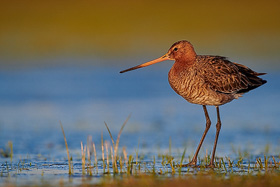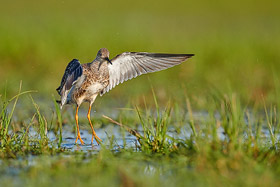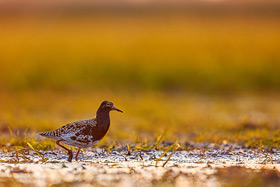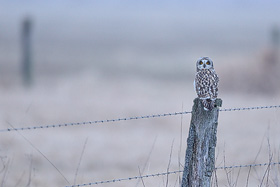- Location and arrival
- The possibilities
- Late in the evening
- The seasons
- The equipment
- Conclusion
- Download maps Ochsenmoor
The Ochsenmoor is located in the district of Diepholz in Lower Saxony, and it lies south of Lake Dümmer. The moor is about 30 km northeast of Osnabrück and about
100 km southwest of Bremen. For those who come from further away, the best way to reach the Ochsenmoor is via the A1 motorway and then taking the Neuenkirchen-Vörden exit.

The Ochsenmoor is a peat bog that was rewetted in the 1980s. The character of the bog resembles wet meadows that are particularly valuable for many ground-breeding
birds. The meadows are only mowed in late summer and should not be entered directly. Until 2019, the Ochsenmoor was a nature reserve and is now only surrounded by the adjacent EU bird
protection area "Dümmer" to the north and the nature reserve "Westliche Dümmer-Niederung". Several
roads
lead through the Ochsenmoor, which are accessible by car. On these roads, slow driving is required (usually at walking pace), as they are also used by pedestrians and cyclists. At the end
of the website, I have uploaded a map under "Download" to better visualize the dimensions of the area.
(back to the top)

As mentioned earlier, taking photographs in the Ochsenmoor is only possible from the paths. You can use the car as a camouflage or, even better, lie at the
edge of the meadows to photograph the birds at eye level. With the appropriate focal length, one can photograph without camouflage. Many birds have become accustomed to visitors and have
reduced their flight distance. If one remains quiet at the edge of the meadow and has enough patience, the chances are quite good to capture many birds in full format. I have often
experienced that Ruffs or Northern Lapwings have approached me up to 2-3 meters. Of course, this does not apply to all species and every bird!

The bird species that can be found in the Ochsenmoor depend on the season. The best opportunities for photography are in the spring. Typically, the first birds to
arrive at the Ochsenmoor are the lapwings, followed shortly by the common redshanks, greenshanks, snipes, and black-tailed godwits. Songbirds such as meadow pipits, skylarks, and yellow
wagtails arrive in larger numbers in May. Reed buntings and many types of warblers (including reed, sedge, and marsh warblers) can also be found in April. In addition to geese and gulls,
I have only listed the most common species that can be photographed well in the spring. Of course, there are many other species that you can encounter more frequently. Although this report
focuses primarily on the Ochsenmoor, I would also like to mention the Dümmer Lake. Since the Dümmer borders directly on the Ochsenmoor, it is also worth a visit. The dike of the Dümmer can
be walked on foot, and from there you have the opportunity, for example, to photograph marsh harriers (in spring/summer) or bearded reedlings (in autumn) at the reed belt.
An overflying osprey or
white-tailed eagle
is also not uncommon here.
(back to the top)

Generally, when it comes to bird photography, I prefer to be out early in the morning, shortly after sunrise, as in my experience, birds are best photographed at this time.
This also applies to the Ochsenmoor, especially since there are often many walkers and cyclists in the evening, which poses an additional complication. Nevertheless, it is also worth visiting
the Ochsenmoor at sunset, as this often provides very beautiful backlit shots against the setting sun. During the week, when the sun sets only after 9 p.m., there are usually very few people
in the Ochsenmoor.
(back to the top)

s already mentioned, spring is certainly the most exciting time for bird photography in the Ochsenmoor, and if someone travels from afar, I recommend the period around May.
However, autumn and winter also offer good opportunities for photography. In winter, the winter guests from northern Europe come to the Ochsenmoor. In particular, the gooses and also the
great white egret
can be found then. In winter, birds of prey (buzzards, kestrels) are also often present in the Ochsenmoor, and with a bit of luck, you might come across a short-eared owl or a bittern searching
for food in the ditches. The summer months, on the other hand, are less suitable as at this time the meadows are mowed and the breeding birds have long since moved on.
(back to the top)
For wildlife photography, telephoto lenses with larger focal lengths (400 mm to 600 mm) are ideal. Depending on the desired composition, a 300 mm lens may also be suitable. It is recommended
to bring a tripod and beanbag as support. Additionally, I recommend bringing a sleeping pad for more comfortable lying down when photographing birds at eye level.
I have been visiting the Ochsenmoor several times a year at various seasons since 2009. The bird population in the Ochsenmoor has fluctuated over the years. Some species are more numerous
in one year and other species decline in numbers in another year. However, the number of nature photographers has been increasing year by year ;-) Ten years ago, one practically had the place
to oneself on a spring morning at sunrise in the Ochsenmoor. Those times are probably over for good, and so I avoid the place, especially on weekends in the spring, and try to be there on
other weekdays. Fortunately, almost all photographers adhere to the rules, and so it is hoped that the bird paradise "Ochsenmoor" will remain forever.
(back to the top)
Here you can download a map of Ochsenmoor. To view and print it, you will need a PDF reader. I hope the map will help you get a better sense of direction while navigating through
Ochsenmoor.
 map Ochsenmoor
map Ochsenmoor
written: June 2021, (author: Olaf Juergens)
updated: May 2022
 print version
print version








